I wish I had the quote handy, but memory will have to suffice for the moment. Bridget Riley, the legendary Op Art painter, once said something along the lines of, “The more you give to your work, the more your effort will show through. Viewers will pick up on this.”
I sincerely hope this will be the case with my newest painting, SuperAcid Autobacs-Ambilify. This work took one month to create, and I scrapped two versions of it before arriving at the canvas pictured here.
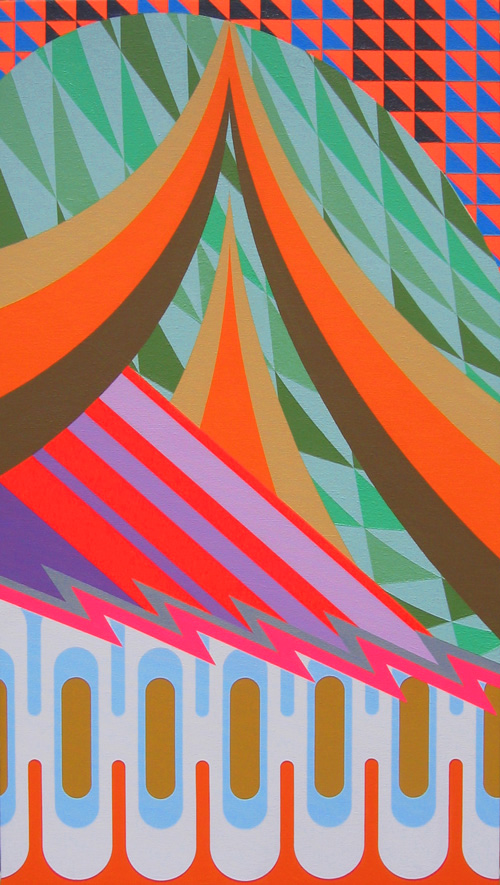
My new painting SuperAcid Autobacs Ambilify, completed on June 7, 2009
Painting SuperAcid, frankly, was a struggle, filled with twists, turns, dead ends, frustration, elation, and opportunity for reflection.
The composition invited ad hoc changes as I went along. The piece began as a rhythmic horizontal composition, but ended up meditative and vertical.
I conceived of it as having one set of colors, but ultimately it took me to a completely different result. Layer upon layer of paint built up, as I changed my mind about which colors to use. I even invited friend and color connoissieur Oliver Hibert to help solve the puzzle I faced when choosing the “right” color for the painting’s final section.
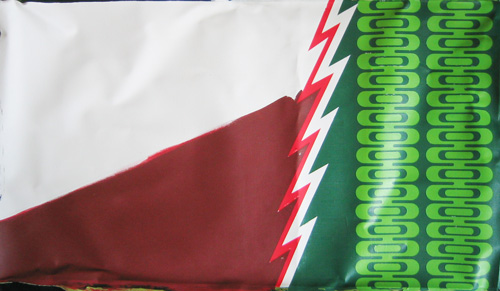
Above: My first pass at SuperAcid, which I bailed upon after three days. Below: Version 2, which I scrapped after a week.
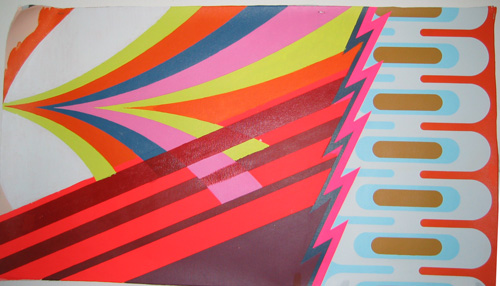
Yet, in the end, I feel like I created a piece that I didn’t understand — that I almost couldn’t relate to — but I nonetheless believe it is important.
Listen and Learn
Describing the finished work to my friend Robert Bell, aka Tradica, when he was paying a visit, I said something that unexpectedly triggered a psychoanalytic interpretation from him.
The sweeping beige, orange, and brown stripes in the center of the work, I pointed out, seemed like a mountain to me. I said this casually, offhandedly, and kept on chatting away.
A few days later, when we talked again, Robert told me that the mountain represented something; I could gather some kind of transformational insight from it. The key is, I had to listen.
In Robert’s opinion, this painting has a symbolism that I might want to explore further:
- If the stripes were a mountain, after all, what did the mountain represent? Minimalist painting?
- If the mountain does represent my minimalist work, are the triangles cutting through them an unconscious representation of a “mix-and-clash” impulse?
- What did it mean that the green triangles were violently cutting through the mountain’s stripes?
- Was I looking down from the top of the mountain?
- Were the triangles trees, and the orange arc at top a sky at sunset?
To my friend, SuperAcid is a very important work — one that, if my house were burning down, I would reach for this painting first. It marks a turning point.
Mind you, I never really study my work this way, and perhaps conveying all of this to you sounds oddly self-important. That is not my intention.
I cannot turn down my friend’s careful and unsolicited interpretation, even though I am not sure what to make of it.
Let the Universe Provide
Quite often I think of this, as it relates to the process of making art: “I can’t know what the future holds. I can only trust in my ability and let the universe provide.”
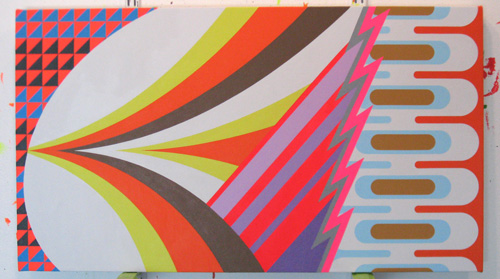
At “halftime” of this painting, I had settled upon a white background for stripes. Everything would change from there.
By throwing myself into the process of a painting — which sometimes feels like the portrayal of the epic struggle to catch a fish in Hemingway’s The Old Man and the Sea — I find that I use a different set of problem-solving techniques. “Improvising out” a painting — rather than designing it completely on a computer monitor first — forces my mind to operate on intuition.
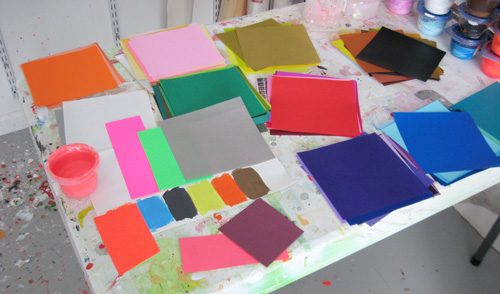
Plotting my next move: Choosing colors using scraps of paper and a set of colored origami paper.
Tactically, I learned these lessons:
- Take chances on color. When Oliver suggested I base an entire section around a mint-green color, I trusted his advice. However, when I started applying the paint, it felt very strange. But I adapted. Sometimes it’s extremely helpful to get an outside opinion on color choices.
- When making an all-over composition that uses almost every color, the balance of colors becomes even more important. You’d think that the more colors you use, the more arbitrary you can be with color choices. Actually, I found the opposite to be true. Color becomes harder and harder to balance as you go.
- Not using white will pay off. Verner Panton is right. There are so many other colors one can use instead of white. The white you see in this painting is actually a very light, foggy gray. No straight-up titanium white here.
- Don’t be afraid to scrap things and start over. But also, know when to pull it together and keep pressing forward. The final version of this painting was my third. I almost junked this third version, but something said to keep moving forward.
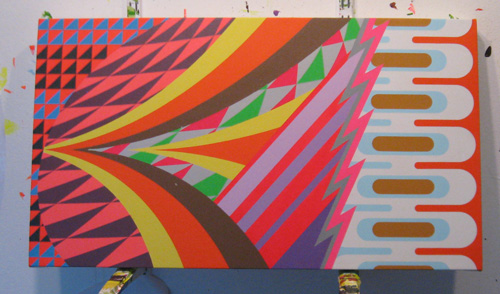
In the final stages of this painting, I chose to paint over nearly all of the central area of the canvas. I just wasn’t satifsfied with my color choices.
Well, that’s my recap. I hope you artists out there can relate to this story even a little bit. Thanks for reading.
Tags: maximalism, paintings


Well… All in all, Your time and effort, I think, where well worth it. I like to see your finished product. To see good art in process and come to fruition inspires me.
Great stuff Grant!
I noticed an amazing color combination in version 2…The middle section of the “pulled” stripes; yellow, orange, blue, pink. What an amazing color combination, I think you should play around with those in a future piece, they seem very fresh… if you dont, I will. 😛
@Jem: Thanks so much for taking time to review my post & saying what you said.
@Oliver: Thanks … the yellow is that one with a bit of gray in it. And the navy is a lighter-looking cousing of the navy you call “Space.” Navy with black in it is very interesting.
Wonderful Painting!!!
I love this painting, especially it’s dimension. I was wondering how you create such bold colors, while still maintain such clean line and edges. Also, the painting’s surface seems SO smooth. How do you do it? Your craft is impeccable!
Thank you very much, Jake. The bold colors are a response to all of the blandness in the world. The clean lines and edges are the result of 0-width paint brushes and a steady hand. Yet, because I changed my mind so much on the colors in this painting, there’s a lot of paint buildup, so it’s not quite as smooth as it seems. Trust me, there are much smoother paintings out there … being self-taught, I’m not the smoothest painter. But thanks anyway!
I am also a self-taught painter. I’m an architecture student and there isn’t enough time to take painting classes outside my Arch classes. It’s a shame so I practice on my own. I am currently trying to make a modern painting, but am completely unsatisfied with my paint lines. It seems that I cannot construct a clean line without corrupting the edge. Well like you said it takes a steady hand. I guess I must work on this.
You said you love compliments, and I can’t look at your work without saying something. So here begins my ramble… Your style is very unique, almost a pioneer in the new realm of minimalism and pop art. I love it. Rhythmic lines and simple shapes are complexly arranged in a captivating composition. I personally find your work interesting and intriguing. Also on a side-note I love reading about your process and seeing your different ideas/compositions. Keep showing your process on the site. It’s a great record of where you came from to reach where you ended…
End of ramble.
Thank you so much, Jake, once again. What you wrote kind of reminds me of my life when I was finishing up my grad school degree in English. I was way more interested in reading Art in America than some English journal.
It took me a long time before I could paint clean lines. But eventually it happened. I think the key is not loading up your brush with paint on your first try. Just make a very slight, slender line at first, then paint it all in with a thicker brush. Eventually, it will just come to you.
As far as process goes, thanks for the vote of confidence. I was beginning to think that my posts about process are a little bit too self-centered, solipcistic, and “all about me,” but really I’m just trying to explain things with the hope that other artists out there will pick up on what I’m talking about, and maybe they’ll encounter something that might actually be useful to them. Artists might work in isolation, but when you learn from others’ examples, you realize that you’re really not alone after all. I’ll keep on writing about my process.
Thank you, Jake, for your kind words, and thank you for understanding.
– Grant